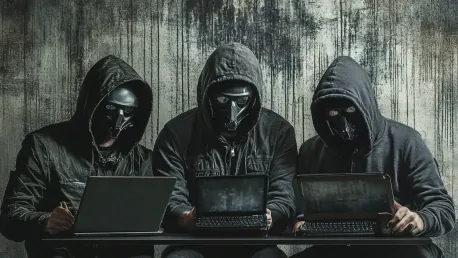Cybersecurity firm Dragos has released an eye-opening report detailing the increasing collaboration between state actors and hacktivist groups targeting critical infrastructure in 2024. The convergence of these groups has significant implications for operational technology (OT) and industrial control system (ICS) security, transforming the threat landscape into a far more complex and volatile field. The report underscores a critical shift where traditional espionage campaigns have diversified into more destructive and sophisticated cyber operations, calling for an urgent reevaluation of current cybersecurity strategies.
Convergence of State and Nonstate Actors
The Dragos report reveals a striking collaboration between three state actor groups and six hacktivist organizations. These groups have not only combined resources but also shared infrastructure and intelligence, particularly to attack OT and ICS targets in conflict zones like Ukraine. This partnership illustrates a significant shift; traditional boundaries between state and nonstate cyberspace actors are blurring, leading to higher levels of coordination and more complex attack strategies. Hacktivist personas are often utilized by state actors for lower-sophistication attacks, serving as distractions or auxiliary forces to engage adversaries on multiple fronts simultaneously.
The merging efforts between these groups suggest that cybersecurity defenders must now prepare for a far more intricate landscape. Espionage-focused campaigns are no longer isolated and may transition into more destructive operations with far-reaching consequences. The ability of these groups to share resources and intelligence means that they can launch highly targeted and disruptive attacks, elevating the level of threat to unprecedented levels. This convergence challenges conventional defensive measures, requiring a more nuanced approach to cybersecurity that anticipates both precision attacks from state actors and widespread disruption attempts from hacktivist groups.
Strategic Implications for ICS Defenders
State actors are notable for their precision, often developing sophisticated malware designed to target specific sites for maximum impact. In contrast, nonstate actors, including hacktivist groups, typically engage in broader attacks, exploiting whatever vulnerabilities they can identify to cause widespread disruption. This dual threat from state and nonstate actors presents unique challenges for ICS defenders, who must now be prepared to combat both highly targeted attacks and indiscriminate disruption attempts simultaneously.
The increasing convergence of state and nonstate actors in cyberspace means that ICS defenders cannot afford to focus solely on one type of threat. They must develop comprehensive security strategies that address both the immediate risks posed by sophisticated state-sponsored malware and the broader, more opportunistic attacks by hacktivist groups. These defenders must implement robust, multilayered security measures that include continuous network monitoring, advanced intrusion detection systems, and real-time threat intelligence sharing. These steps are crucial for identifying and mitigating threats before they can cause significant damage to critical infrastructure.
Case Study: Ukraine-Russia Conflict
The ongoing Ukraine-Russia conflict has served as a prominent battleground for cyber activities over the past four years. This region has witnessed a high level of activity from groups such as KAMACITE and ELECTRUM, which have repeatedly targeted Ukrainian critical infrastructure. By leveraging each other’s strengths, these groups have been able to execute highly impactful attacks that disrupt essential services and create widespread chaos. The Cyber Army of Russia Reborn (CARR) hacktivist group is closely linked to state actors ELECTRUM and KAMACITE, known for causing electric grid outages in Ukraine in 2015 and 2016. Additionally, ELECTRUM collaborates with hacktivist groups KillNet and Solntsepek, while KAMACITE has connections with XakNet.
These collaborations exemplify how state and nonstate actors can synergize their efforts to achieve significant disruption. By sharing resources, intelligence, and infrastructure, these groups enhance their capabilities and execute more sophisticated and impactful operations. ICS defenders in Ukraine and other regions must recognize and adapt to these evolving tactics, implementing defensive strategies that anticipate the possibility of such coordinated attacks. The introduction of more advanced and persistent cyber threats underscores the necessity for constant vigilance and the need for comprehensive, proactive cybersecurity measures.
Strategic Objectives of State Actors
Some state actors have adopted a strategy of minimizing direct blame for attacking civilian infrastructure by employing nonstate proxies. This approach allows them to achieve their objectives while maintaining plausible deniability, complicating attribution and response efforts for targeted nations. High-consequence attacks, particularly during critical periods such as election years, can instill fear in the public and potentially influence political outcomes, making this a powerful tool for state actors seeking to exert influence without facing direct repercussions.
The use of nonstate actors to conduct these attacks further obscures the origin of the threat, complicating efforts to accurately attribute the attacks and respond effectively. This tactic is especially concerning for ICS defenders who must contend with the dual challenge of identifying the true source of the threat while mitigating its impact. To counter this strategy, defenders must enhance their threat intelligence capabilities, enabling them to identify patterns and connections that reveal the underlying state-sponsored nature of these attacks. Additionally, diplomatic efforts and international cooperation are crucial for addressing the broader geopolitical implications of such cyber activities.
Broader Geopolitical Context
The Dragos report highlights continued cyber activities targeting infrastructure linked to geopolitical conflicts extending beyond Europe to other regions facing similar challenges. In Asia, for example, the OT-focused unit VOLTZITE targets strategic sites to compromise essential services, underscoring the transnational nature of these threats. Such activities emphasize the necessity for global cooperation and intelligence sharing to combat the evolving cyber threat landscape.
Nations must work together to identify and neutralize these threats before they cause significant disruption. The interconnectedness of modern critical infrastructure means that a cyberattack in one region can have cascading effects worldwide, making it imperative for countries to develop collaborative defense mechanisms. Enhanced information sharing, joint threat assessments, and coordinated response strategies are essential components of an effective international approach to cybersecurity. By building stronger alliances and fostering a shared understanding of the threat landscape, nations can improve their collective resilience against state and nonstate actor attacks.
New ICS Malware Variants
In 2024, two significant new ICS malware variants emerged related to the Ukraine-Russia conflict: FrostyGoop and Fuxnet. Both demonstrated the potential for causing severe disruption, with FrostyGoop manipulating instrument measurements to trigger heating outages in Ukraine during the winter. This example highlights the cruel intentions behind such attacks, aiming to maximize suffering during periods of vulnerability. Similarly, Fuxnet, used by the hacktivist group BlackJack, targeted Moscow’s gas, water, and sewage networks, although the details of its impacts remain relatively scarce.
These malware variants underscore the evolving nature of cyber threats, which continue to grow in sophistication and potential for widespread disruption. The emergence of such advanced malware necessitates a corresponding evolution in defensive measures. Organizations must prioritize continuous monitoring of their ICS environments, ensuring that they can detect and respond to threats in real time. In addition, a focus on developing and implementing robust security protocols that account for the unique challenges posed by ICS malware is essential for mitigating the risks associated with these highly destructive cyber threats.
Ransomware Trends
Ransomware continues to be a major threat in the cybersecurity landscape, particularly in the manufacturing sector, with attacks increasing by 87 percent in 2024. Hacktivist groups have increasingly adopted ransomware as part of their operations, highlighting the convergence of economic, political, and ideological motives in the evolving threat landscape. The growing prevalence of ransomware attacks underscores the importance of organizations implementing robust cybersecurity measures to protect against these threats.
Organizations must remain vigilant and proactive in their cybersecurity efforts to mitigate the risks associated with ransomware attacks. This includes regular data backups, employee education on identifying and responding to phishing attempts, and the development of comprehensive incident response plans. By fostering a culture of cybersecurity awareness and implementing robust defense mechanisms, organizations can better protect themselves from the potentially devastating impacts of ransomware.
Preventative Measures and Recommendations
To address the complex and evolving nature of cybersecurity threats, organizations are advised to increase education on phishing attempts and maintain strict network segmentation between IT and OT/ICS networks. Ensuring comprehensive visibility into ICS environments is crucial for detecting and preventing suspicious activities. Basic security measures such as monitoring and disallowing unauthorized application installations are recommended, alongside creating backups of engineering files and disabling service changes to mitigate the impacts of wiper malware like those used by ELECTRUM.
Organizations must adopt a proactive approach to cybersecurity, continuously evaluating and updating their defenses to stay ahead of emerging threats. Regular security assessments, penetration testing, and adherence to industry best practices can help identify potential vulnerabilities and ensure that defensive measures are up-to-date and effective. Collaboration with industry peers, government agencies, and cybersecurity experts can also provide valuable insights and resources for enhancing an organization’s overall security posture.
Emerging Threat Actors
Cybersecurity firm Dragos has released an alarming report that highlights a growing partnership between state actors and hacktivist groups aimed at critical infrastructure in 2024. This collaboration marks a significant change in the operational technology (OT) and industrial control system (ICS) security landscape. The report reveals that this blending of groups has resulted in a more intricate and unpredictable threat environment.
Importantly, Dragos emphasizes that traditional espionage efforts have evolved. Rather than just gathering intelligence, these efforts now include more devastating and advanced cyber operations. This shift is crucial because it could lead to severe disruptions in essential services and industries that depend on OT and ICS systems.
The report sounds a clear warning: the current cybersecurity strategies that organizations rely on are no longer sufficient to defend against these newly sophisticated threats. Companies and agencies tasked with protecting critical infrastructure must urgently reassess and fortify their cybersecurity defenses. Understanding the nature of these evolving threats and preparing for them is essential to safeguarding vital systems and operations. This new era of cyber threats demands a proactive approach and heightened vigilance to mitigate potential damage effectively.









